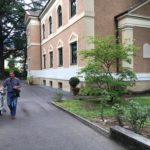Traveling south from Hohenems you run into into the Italian city of Merano—the place where North meets the South. Palms everywhere along the promenade, and the surviving glory of another epoch: this spa town was once the hotspot of Hapsburg and German elites and intellectuals looking for a decent retreat with Italian flavor—without leaving the German speaking world. It also became a meeting place for Jews from all over, who spent their month-long vacations here (as it was the habit of urban middle and upper classes of the time).
But a growing number settled and lived here on a permanent basis, being part of a more or less informal Jewish community, formally represented by the “Landesrabbiner for Tyrol and Vorarlberg,” who until 1915 was also the Rabbi of Hohenems. But when Italy changed sides during World War I and annexed Southern Tyrol, Merano was cut from its former ties and the Jewish community also became Italian.
Today the town is occupied by German tourists who are enjoying “Südtirol” – with not a particular interest in the idea of “European culture,” The region is officially named “Alto-Adige / Südtirol,” and is subject to autonomy agreement that allows the existing German speaking majority in some of the valleys to enjoy there cultural ego, and whatever is needed for that. History is a minefield in this atmosphere of “compromise.” In the 1960s, Tyrolian separatists still threatened the Italian “rulers” with explosives. And in Bolzano, the accord between Italian Fascists and communist partisans (or better: their offspring) sometimes seem still more profound than between the “Germans” and the “Italians.”
Strolling around the town, we still see many of the belle epoch Hotels and sanatoriums that made the fortune of Merano. While the memory of two world wars still inhabits some of the population, the wars have not left any visible impact. There are only traces of 1920s and 1930s modernism—which in Italy means the better part of Italian Fascist architecture. When Merano became well-known between the 1860s and 1914 among the medical doctors and tourism developers, the founders of Hotels, brewers and railroad pioneers in Southern Tyrol and Bozen Jews from Hohenems and elsewhere played a decisive role. The Biedermans from Hohenems opened the first bank in Merano, and the Schwarz from Hohenems did the same in Bozen, in addition to starting a modern brewery and developing a railroads and funiculars which enabled the growing tourism to explore the smoother hilltops and sunny plateaus between the valley and the high mountains. Others like Dr. Rafael Hausmann invented the “grape cure” and turned the town into a European center of spa and “wellness” before the term was coined.
With the beginning of the new century, right in 1900, a synagogue was built in Merano. It was inaugurated by Rabbi Aron Tänzer from Hohenems in 1901. A sanatorium for poor Jews had already opened, the “Asyl für mittellose kranke Israeliten.”All this without a formal Jewish community but due to a foundation, the “Königswarter Stiftung,” started by the parents of a young Jewish student from Frankfurt who had died in Merano. They also installed a Jewish cemetery, so the basic institutions were able to accommodate the almost 1000 Jews living here around 1900 (many more than the members of the shrinking Hohenems community). And for the growing number of observant or even orthodox Jews (living in Merano or coming for vacation and cure) the Berman family offered a luxurious hotel, the Bellaria, with kosher food, a Mikvah and a second—orthodox—synagogue. For a short time, Merano was a kind of Jewish paradise.
Back in the present day, the small contemporary Jewish community has run a Jewish museum in the basement of the synagogue for almost twenty years. We enjoyed meeting longtime friends Joachim Innerhofer and Sabine Mayr, who today take care of this place. The permanent exhibition they “inherited” from community president Steinhaus, they know, is rather poor and outdated and there are some ideas in the air to start a new project. They already published a great new book about the history of the Jews in Merano. A new museum could turn the contested history of Merano (and the unique role of Jews in that history) into a starting point for new discourse about Europe—something desperately needed in times where the economic foundations of Europe seem to be only a matter of business, the essential and hard fought for European values of peace, solidarity and human rights seem to be worn out, and some pray for right wing populists to rebuild walls inside and outside of the European community once more. Whether there will be political support for bringing this little utopia of Jewish history in Merano to new life (even in a museum) is far from settled. But at least there is a new generation of politicians on both sides who do not completely follow the old ideologies.
When we climbed the slopes of the Ortler, with its 3900 meter once the highest peak of the Hapsburg Empire (and subject of battles in World War I), we entertained some of these utopian ideas in the low pressure of the mountain. And we still had enough breath for that, as we didn’t meant it to serious with the “climbing”, ending our hike just over 3000 meter in the wonderful “Payer Cabin” with a glass of beer.









Always great to learn more history of Hohenems and the area.
thank you
What is the “grape cure”
The “Traubenkur” (Grape cure) is something very nice: you eat the very taste grapes of Merano and it helps. I actually have no idea how. But I think I will google it 😉
Cheers
Hanno